Update, June 16, 2019: After searching in many places (Hebrew texts, Masonic literature, and sources on ciphers and scripts) for alternate sources for the archaic Hebrew letter beth that W.W. Phelps may have picked up (as discussed below) from Moses Stuart’s book that Oliver Cowdery brought to Kirtland on Nov. 20, 1835, I found a reasonable though perhaps less likely source that weakens my case for Moses Stuart as a key influence on W.W. Phelps’ Egyptian Counting document. I discuss the new find and its implications in my June 16 post, “Update on Inspiration for W.W. Phelps’ Use of an Archaic Hebrew Letter Beth for #2 in the Egyptian Counting Document.” The original post here follows.
Update, May 21, 2023: Joe Staker noted that a copy of Stuart’s book has a note signed by President John Taylor saying that “this book was probably used by some members of said class,” referring to the Hebrew class taught by Joshua Seixas in Nauvoo. You can see the note at Archive.org (https://archive.org/details/grammarofthehebrewlanguage1831mosesstuart/page/n1/mode/2up). Here is one view of it:
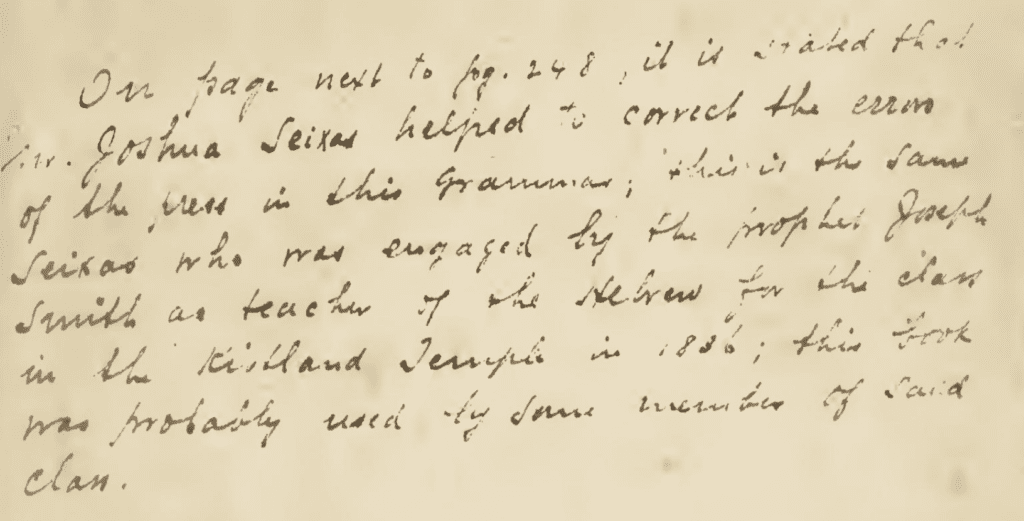
I was intrigued by a statement from John Gee about the apparent influence of Joshua Seixas on the spelling of names in the Kirtland Egyptian Papers, but after reviewing the two books on Hebrew written by Seixas, I don’t see evidence to support John’s theory that using “h” after long vowels came from his influence. However, there may be evidence that one of the Hebrew books brought to Kirtland by Oliver Cowdery in late November 1835 may have influenced the content of the Kirtland Egyptian Papers.
I’ve looked over Seixas’ 1830 book on Hebrew grammar at Archive.org and his later edition, available at Google Books, and just don’t see a system where long vowels are followed by an “h.” There still may be a connection to Seixas, but I don’t see the evidence. Of course, transliterations of Hebrew do tend to have many words with “eh” and “ah,” somewhat similar to the KEP, so there could be a link.
Matthew Grey mentions some of the specific Hebrew books that we know Oliver Cowdery brought to Kirtland in November 1835. See his chapter, “‘The Word of the Lord in the Original,’” in Approaching Antiquity: Joseph Smith and the Ancient World, edited by Lincoln H. Blumell, Matthew J. Grey, and Andrew H. Hedges (Provo, UT: Religious Studies Center; Salt Lake City: Deseret Book, 2015), 249–302. One possibility is the 1830 edition of A Hebrew and English Lexicon of the Old Testament (link is to the 1824 edition) of Wilhelm Gesenius and Josiah Gibbs, but it has very little transliteration if any. The 1831 Biblia Hebraica lacks transliteration. But I think Moses Stuart’s A Grammar of the Hebrew Language could have played a role in influencing the Kirltand Egyptian Papers. For one thing, it seems to have a lot of h’s with words like bah-hel and ruhh-hhats. But look at the very beginning, where the Hebrew alphabet is presented:
[Note, May 12, 2019: I just realized that the figures here come from the 1838 6th edition of Stuart’s book at Google Books, whereas Cowdery brought the 1835 5th edition. Google Books also has the 1835 5th edition, where you can see the chart above is essentially the same but cleaner and still on the same page, p. 10.]
Here we have the letters of the Hebrew alphabet transliterated as Aleph (unlike auleph from Seixas), Beth, Gimel, Daleth, He, etc. Now look at the document in the Joseph Smith Papers Project that is named, “Grammar and Alphabet of the Egyptian Language, circa July–circa November 1835.” Here is page 33, with screenshots followed by the transcription, wherein I’ve made some parts bold that may be related to Moses Stuart’s alphabet:
Transcription from the Joseph Smith Papers Project:
✦ Ahme=as= God without begining or end
✦ Alkibeth minister of God under or the less
✦ Baethkee The first next from Adam, one one ordained under him, a patriarch or the right of the first born.
✦ Bethka another place of residence, made so by extension so by appoinment.
✦ Bethka— Another & larger place of residence made so by appointment. by extension of power; more pleasing, more beautiful: a place of more complete happiness, peace and rest for man.
✦ Bethku=ain-tri=eth: The whole earth, or the largest place, the greatest enjoyment an earth the garden of the earth
✦ Dah tu Hah dees: Hell another Kingdom; the least kingdom, or kingdom without glory; the whole kingdom and dom[a]in of darkness, with all its degrees and parts. governed by the Doagrass him who is an enemy to G<o>od.
✦ Gahmel:— a fair prospect of anthing: Landscape; a place or country: face of The face of the country; beautiful scituated; an country under a promantory= a promising situation for man.
✦ Jah=ho ni hah; One delegated with redeeming power; a swift messenger; one that goes before another; one having redeeming power, a second person in authority;
✦ Jah=oheh: The earth including its affinity with the other planets, with their govering powers: which are fifteen: the earth; the sun, and
The first word seems to draw upon Ahman that Joseph Smith had previously given and that W.W. Phelps used in his May 1835 “pure language” letter with six strange characters, written before Joseph ever saw the scrolls. “Ahme=as” as God (similar to Ahmen, a name for God in Joseph’s revelations) could fit the concept of Aleph, the First. Aleph also may be hinted at in the “Alkibeth” name that seems to link man to God, or beth to aleph. Then we have a series of beth-related names, some of which imply a “secondary” nature (like beth itself as the second letter), such as “The first next from Adam, one one [sic] ordained under him” or “another place of residence, made so by extension.” “Another place of residence” seems to combine the concept of second/secondary with house, both related to Hebrew beth.
Next come two names arguably related to daleth and gimel: “Dah tu hah dees” (“dah” for daleth) and “Gahmel.” Then we have two names that may draw upon he. On one page, we see links to aleph, beth, gimel, daleth, and he, in almost the same order. This page, in the handwriting of W.W. Phelps, may be drawing upon his study of Hebrew using a Hebrew book by Moses Stuart that came to town in late Nov. 1835. Joseph and his brethren began studying Hebrew on their own at this point, and the translation of the scrolls was dropped. They soon realized they needed help and in early 1836, hired Joshua Seixas to teach them. But it seems that the details of the Kirtland Egyptian Papers may have already been influenced by Hebrew before they learned his transliteration system.
If Moses Stuart has indeed influenced the content of the Kirtland Egyptian Papers through the Saint’s vigorous study of Hebrew on their own before Seixas arrived, it would suggest that these documents, dated as July to November 1835 by the editors of the Joseph Smith Papers, may need to be reconsidered. A date of December 1835 to roughly March 1836 may be more appropriate.
Perhaps the most important clue here is that the Hebrew coin letter for beth, the second letter in the Hebrew alphabet given by Stuart on the right-hand side of his page 10, is identical to the non-Egyptian symbol for the number 2 given in the KEP’s strange Egyptian Counting manuscript, dated by the JSPP as from July 1835 to Nov. 26, 1835. Very odd. Here’s a close-up of the Egyptian Counting document’s numbers 1 and 2, and Stuart’s coin letters for aleph and beth:
The Egyptian Counting number for 2 matches Stuart’s leftmost Hebrew coin letter for the second letter beth and is similar to the other one shown and to the Samarian letter shown. That seems to be rather strong evidence for a link between Stuart’s book at the KEP, especially when the sound beth is used with meaning similar to “secondary”. The Egyptian Counting number for 1 does not resemble the coin letters for aleph, but looks related to (an upside-down version) of the leading “Egyptian” word introduced on page 3 of the Grammar and Alphabet of the Egyptian Language which is said to be “Ahlish,” a name similar to aleph, with a meaning to match:
The transcription reads: “Ah lish The first Being— supreme intillegence; supreme power; supreme glory= supreme Justice; supreme mercy without begining of life or end of life comprehending all things, seeing all things: the invisible and eter[n]al godhead”. (There’s enough of a squiggle after the “r” in “eternal” that I think the author, W.W. Phelps for this part of the document, should be credited with “eternal” rather than a typo that requires an editorial addition of [n], but that’s a minor issue.) The point here is that the “Egyptian” number for 1 here could be related to a character in the Grammar and Alphabet of the Egyptian Language assigned a sound and meaning related to aleph. That detail suggests that awareness of the Hebrew alphabet influenced the KEP in some way, though not necessarily anything from Stuart.
The case for Stuart’s specific influence is greatly enhanced by noting that the “Egyptian” number for 2 appears to be taken from Stuart and is not likely to be due to random chance since it’s an unusual and more complex character, is used without any significant modification like inversion, and the associated Hebrew name of beth is used in “Egyptian” words in the KEP with a reasonably related meaning pertaining to secondary concepts. I don’t think chance alone can explain these parallel, along with the previously discussed connections to the first five letters of the Hebrew alphabet as presented by Stuart.
To me, it seems that Stuart’s book may have influenced both the Egyptian Counting manuscript and the Grammar and Alphabet of the Egyptian Language. Could those documents both date to after Hebrew study had begun with Moses Stuart’s book in hand? The latest listed possibility of Nov. 26 in the JSPP for the Egyptian Counting document might work, but still seems a bit early.
By the way, one of the strange things that struck me looking at Stuart, perhaps just a coincidence, is Stuart’s listing of “O” as the Hebrew coin character symbol on the same line as the “k” sound (see the upper right portion of the second image from Stuart’s page 10 above), though it’s really associated with ayin shown at the right of that column, but something that could easily confuse someone (or at least confuse me). A similar “O” symbol was also the sign associated with the name “Katumin” in Phelps’ July 1835 letter that lists some Egyptian and a “translation.” Are we sure about July 1835 as the date of Phelps’ notebook? But I think that’s just a coincidence and I suspect someone trying to study Hebrew would quickly realize that the “O” is not linked to a “k” sound after all.
Update, May 10, 2019: The Joseph Smith Papers website provides “Gahmel” in the transcription of page 33 of the Grammar and Alphabet document discussed above, but a closer look suggests that this is another minor error in the transcription. (There are actually quite a few such error in this manuscript that I may discuss later.) I think it should be “Gahmol.” Comparing other examples of “el” and “ol” on this page suggests to me that “ol” is the better fit. The minor error, if it is an error, slightly strengthens my case for a relationship, but in either case, the word written is clearly similar to and possibly cognate with Stuart’s “Gimel.”
Update, May 11, 2019: If W.W. Phelps were inspired by the Hebrew alphabet in constructing an Egyptian alphabet, there may be other correspondences to consider.
For example, what if the first character considered were somehow associated with aleph? Notice Stuart’s “coin letter” versions for aleph, one of which is essentially our letter “V” with a line through it, like an inverted letter “A.” This has much in common with the first character listed by Phelps on page 1 of the Grammar and Alphabet:
Then come some beth-related words on page 2, where we learn that “beth” is a place of happiness, which fits nicely with the Hebrew meaning of the letter beth, “house.”
After “beth,” we then have a mysterious character on page 2 that is said to be “Ah brah-oam” (though the JSPP has Ah brah-aam). That character looks a lot like the Arabic alphabet letter corresponding to Hebrew daleth, as shown by Stuart above.
Further, the mysterious “iota”character, presented as just a round dot on page 3, may be related to the Hebrew letter yodh, which can function as a “y” sound or as the vowel “i”. There might be a connection to the Syriac alphabet version of yodh from Stuart at the far right in the Stuart image below:
Glancing through the GAEL and the various Egyptian Alphabet manuscripts, there does seem to be this odd pattern of sections that include “A”-related words like “aleph” itself, “ah-lish,” etc., then a transition to words involving “beth” or “baeth,” followed by words beginning with “d” as in daleth, and then a word that sounds like gimel. That alone suggests that someone was using Hebrew to help them study Egyptian, which in turn suggests that that these documents were at least still being drafted after November 20, 1835, when Oliver brought a collection of Hebrew books including the work of Moses Stuart to Kirtland, Ohio, sparking intense interest in Hebrew. But the apparent use of some of the unusual characters from Moses Stuart’s page 10 in some portions of the Kirtland Egyptian Papers, especially the Hebrew coin symbol for the second letter, beth, as the number 2, and perhaps also the Arabic character for daleth helps suggest Stuart was an actively used source for some of the thinking (crazy at it may have been) by the scribes composing the KEP.
Related issues can be further explored by examining the facsimile volume for The Joseph Smith Papers, Revelations and Translations, Volume 4: Book of Abraham and Related Manuscripts, edited by Robin Scott Jensen and Brian M. Hauglid (Salt Lake City, UT: Church Historian’s Press, 2018). Especially helpful is the final section, “Comparison of Characters,” pp. 350-380, where one can see groupings of (nearly) every distinct character from the GAEL, the Egyptian Alphabet documents, and the Book of Abraham manuscripts.
Looking through that book, it is rather startling to see how very few of the many characters considered in the GAEL are actually used on the Book of Abraham manuscripts, and especially startling to see how few of the 28 characters on the Book of Abraham manuscripts are actually found in the GAEL or the Egyptian Alphabet documents. Of those 28 characters, I see only 3 (labeled characters 3.11a, 5.27, and 5.28) that are in the GAEL or the Egyptian Alphabet documents, one of which is part of the 18 characters said to be found on the scroll called the Fragment of Breathing Permit for Horus-A, with 8 characters apparently not found on the scrolls or in the GAEL or Egyptian Alphabet documents. If the GAEL supposedly shows us how Joseph did the translation, it seems to apply to only about 10% of the characters in the margins of the Book of Abraham manuscripts. The numbers raise serious doubts to common theories about how the translation was done. One can claim that the GAEL wasn’t needed since we can see evidence of Joseph translating on the fly from the characters in the margins of the Book of Abraham manuscripts A and B, which show evidence of two scribes simultaneously copying down text that someone was reading. However, a careful look at the two texts shows clear evidence that what was being dictated was an already existing text, not one being created. Further, the evidence suggests that one of the scribes was reading aloud for the benefit of the others. Once that scribe left, the other scribe continued on his own and made a classic scribal copying blunder that is very unlikely if someone is dictating newly composed text. These issues are discussed in my previous post, “The Smoking Gun for Joseph’s Translation of the Book of Abraham, or Copied Manuscripts from an Existing Translation?“
On p. 380, Volume 4: Book of Abraham and Related Manuscripts, one of the characters (part of a two-character pair) in the margins of some Book of Abraham manuscripts is said to be found on the papyrus fragment labeled as Fragment of Breathing Permit for Horus-A, which is shown on p. 9 of the book. Even higher resolution is possible by viewing this fragment on the JSPP website on page 19 of the collection of papyrus fragments (although pages without English text are generally all listed as page 0 on the slider for page selection). Here we compare the characters in the margins of the Book of Abraham manuscript C with an enlarged view of the portion of the scroll said to be the source:
The character on the left from the papyrus fragment has ink that appears to have already come to an end near the end of the lacuna suggesting that upper part of the character may not be a good match. [Update, May 20, 2019: An earlier photograph in Matthew Rhodes’ 2002 book, The Hor Book of Breathings, shows the ink reaching to the edge of the lacuna more fully. Perhaps a piece of the manuscript flaked off between that photo around 2000 and the photography session 15 or so years later for the Joseph Smith Papers Project. If that is correct, then the drawn character may adequately reflect what was on the scroll. Still a cool coincidence that the Moses Stuart Hebrew coin letter would be identical. Maybe that means something.] The distribution of ink in the lower half also does not closely fit the character drawn on the Book of Abraham manuscript. While speculative, consider the possibility that this character might have come from one of the Hebrew coin or Aramaic versions of a Hebrew letter from Stuart’s book, in this case the Hebrew letter mem. The two characters on the left are Hebrew coin letters, the Aramaic version is in the central column, and the Hebrew is on the right:
That seems like a perfect fit for the character drawn by one of Joseph’s scribes. The other character on its right is a fairly common one in the scrolls and similar characters occur in the GAEL, so this pairing could have happened, though the two together do weight for the papyrus scroll being the source of the concept, and perhaps the modern scribe just copied it poorly.
An apparently compound character is on p. 6 of Manuscript C:
The leftmost part might have a relationship to Stuart’s Hebrew coin characters for the Hebrew letter tsadhe:
But that may not be a great fit. The most interesting issues, in my opinion, involve the use of names related to the letters aleph, beth, gimel, daleth, and possibly yodh, coupled with the surprising link to Stuart’s Hebrew coin letter for beth as the number 2 in the Egyptian Counting document, and possibly a few other relationships involving the KEP and Stuart’s page 10.
In any case, for further research, I think we need to more carefully consider Moses Stuart and not just Joshua Seixas when exploring the impact of Hebrew study in the KEP. And we also may need to reconsider the dates that have been listed by the editors of Volume 4 of the Joseph Smith Papers, for at least many portions of the KEP may not have been written until well after Hebrew study had commenced at the end of 1835 or the beginning of 1836. That also would raise new challenges for those looking to the KEP as evidence of how Joseph translated. If they were prepared after the translation was already done or largely done (a hypothesis already supported by textual evidence), then they may tell us about W.W. Phelps’ thoughts on “pure language” or tell us about attempts to cipher English text (per William Schryver) or tell us about some kind of failed attempts of mortal men to figure out how to understand Egyptian by working with an already translated text or show us how some scribes sought to find hidden clues in one part of the papyrus that had thematic links to what Joseph had translated, but they would not tell us how the revealed translation was done in the first place.
Update, May 20, 2019: The presence of Hebrew letter names does not require Hebrew study, of course, since these names can be picked up from the KJV itself in Psalm 119. But why use Hebrew characters at all in the first place? The push for Hebrew study seemed to be driven by the need to better understand ancient language in order to better understand Egyptian. Combined with the other evidences for ties to Hebrew study materials discussed here and in my May 20 post, I think there is a collective case that requires us to at least be open to the possibility that Hebrew study sparked significant portions of the Kirtland Egyptian Papers. The May 20 post is “More on the Impact of Hebrew Study on the Kirtland Egyptian Papers: Hurwitz and Some Curiosities in the GAEL.”
This post is part of a recent series on the Book of Abraham, inspired by a frustrating presentation from the Maxwell Institute. Here are the related posts:
- “Friendly Fire from BYU: Opening Old Book of Abraham Wounds Without the First Aid,” March 14, 2019
- “My Uninspired “Translation” of the Missing Scroll/Script from the Hauglid-Jensen Presentation,” March 19, 2019
- “Do the Kirtland Egyptian Papers Prove the Book of Abraham Was Translated from a Handful of Characters? See for Yourself!,” April 7, 2019
- “Puzzling Content in the Egyptian Alphabet and Grammar,” April 14, 2019
- “The Smoking Gun for Joseph’s Translation of the Book of Abraham, or Copied Manuscripts from an Existing Translation?,” April 14, 2019
- “My Hypothesis Overturned: What Typos May Tell Us About the Book of Abraham,” April 16, 2019
- “The Pure Language Project,” April 18, 2019
- “Did Joseph’s Scribes Think He Translated Paragraphs of Text from a Single Egyptian Character? A View from W.W. Phelps,” April 20, 2019
- “Wrong Again, In Part! How I Misunderstood the Plainly Visible Evidence on the W.W. Phelps Letter with Egyptian ‘Translation’,” April 22, 2019
- “Joseph Smith and Champollion: Could He Have Known of the Phonetic Nature of Egyptian Before He Began Translating the Book of Abraham?,” April 27, 2019
- “Digging into the Phelps ‘Translation’ of Egyptian: Textual Evidence That Phelps Recognized That Three Lines of Egyptian Yielded About Four Lines of English,” April 29, 2019
- “Two Important, Even Troubling, Clues About Dating from W.W. Phelps’ Notebook with Egyptian “Translation”,” April 29, 2019
- “Moses Stuart or Joshua Seixas? Exploring the Influence of Hebrew Study on the Grammar and Alphabet of the Egyptian Language,” May 9, 2019
- “Egyptomania and Ohio: Thoughts on a Lecture from Terryl Givens and a Questionable Statement in the Joseph Smith Papers, Vol. 4,” May 13, 2019
- “More on the Impact of Hebrew Study on the Kirtland Egyptian Papers: Hurwitz and Some Curiosities in the GAEL,” May 20, 2019
- “He Whose Name Cannot Be Spoken: Hugh Nibley,” May 27, 2019
- “More Connections Between the Kirtland Egyptian Papers and Prior Documents,” May 31, 2019
- “Update on Inspiration for W.W. Phelps’ Use of an Archaic Hebrew Letter Beth for #2 in the Egyptian Counting Document,” June 16, 2019
- “The New Hauglid and Jensen Podcast from the Maxwell Institute: A Window into the Personal Views of the Editors of the JSP Volume on the Book of Abraham,” July 1, 2019
- “The Twin Book of Abraham Manuscripts: Do They Reflect Live Translation Produced by Joseph Smith, or Were They Copied From an Existing Document?,” July 4, 2019
- “Kirtland’s Rosetta Stone? The Importance of Word Order in the ‘Egyptian’ of the Grammar and Alphabet of the Egyptian Language,” July 18, 2019
- “The Twin BOA Manuscripts: A Window into Creation of the Grammar and Alphabet of the Egyptian Language?,” July 21, 2019
- “A Few Reasons Why Hugh Nibley Is Still Relevant for Book of Abraham Scholarship,” July 25, 2019

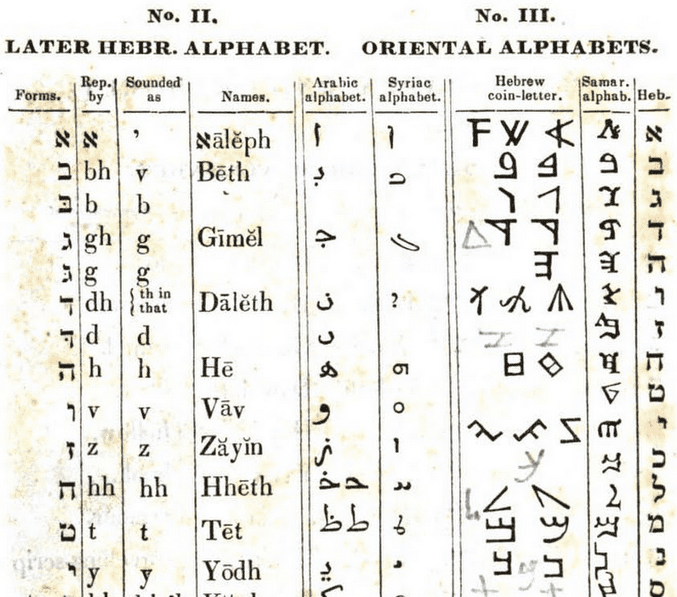
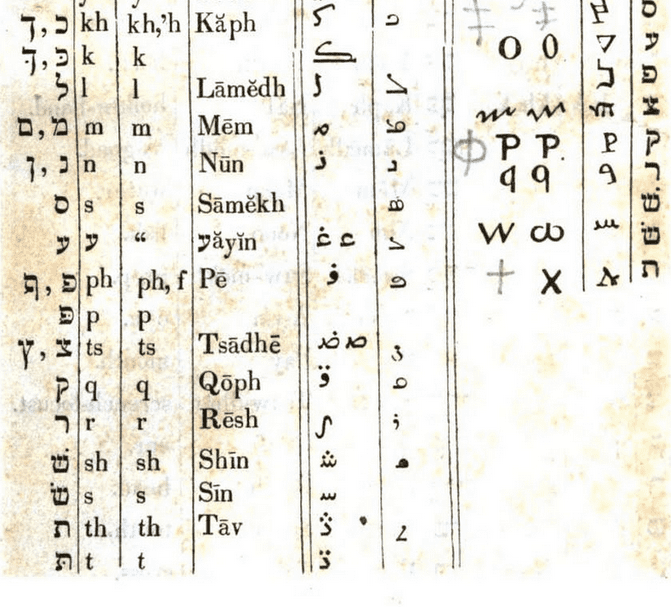
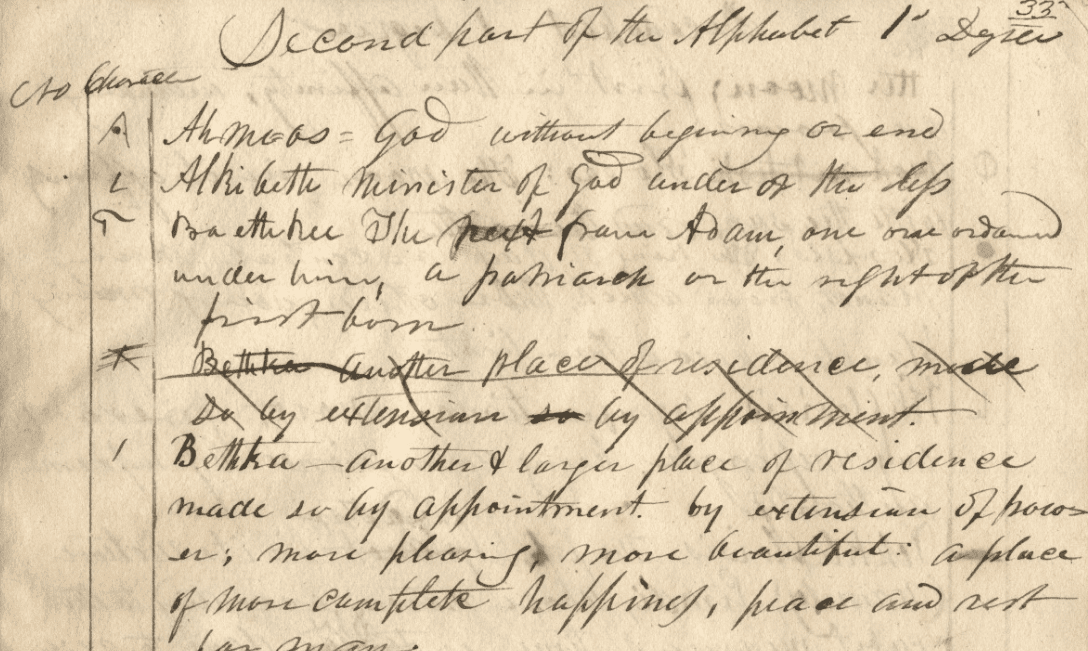
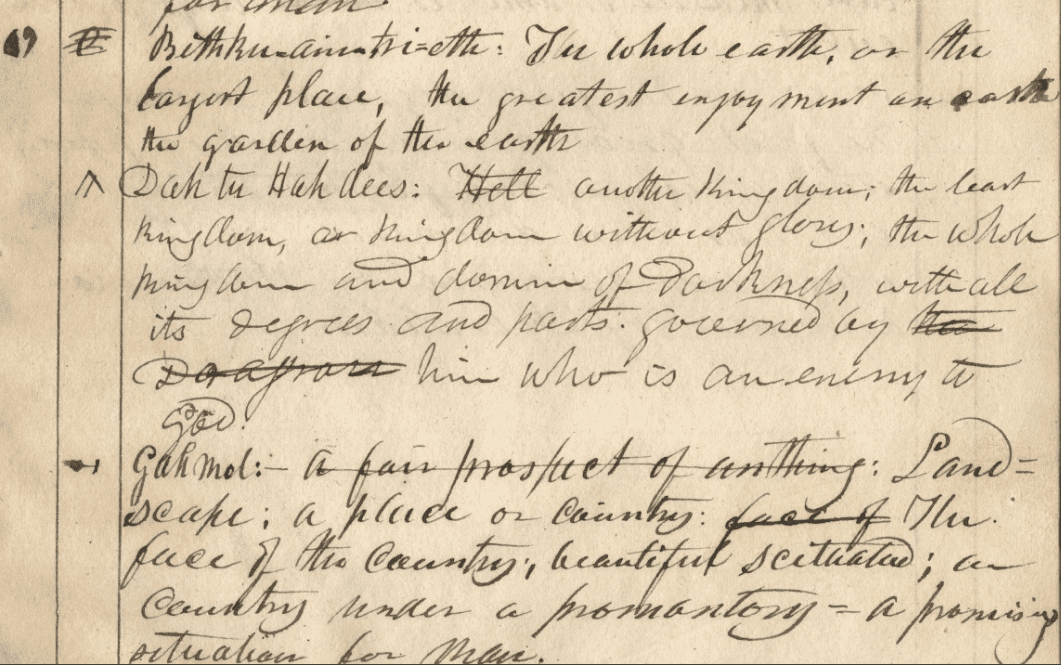
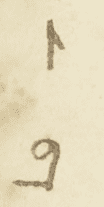
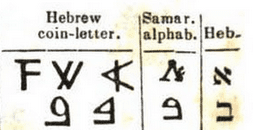




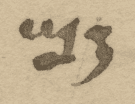
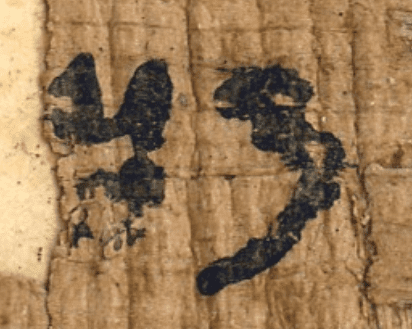

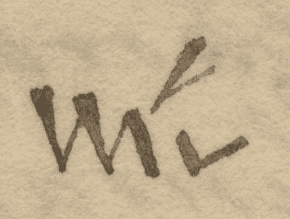









Brilliant! I'll want to read this several more times…:)
For one thing, I've wondered why he/they associated Iota/Yohd with seeing, I'd think that would be ayin, the eye. It's probably nothing but, for fun, just thinking, as the life force (or Ki/Chi for those of you in the east ; )), Yohd also represents divine wisdom, the tree of life/wisdom, Chokhmah, the drop of creative life, etc. So, in the sefirot, Yohd is the right eye, insight, knowledge, the Divine image= wdjet, Horus (and Abraham as the apple of the eye/Kolob). Of course, that's probably just chance, doubt they studied Kabbalah, but they probably did make it to Eve and the tree of life. And, obviously, they knew Abraham was on that path, seeking light and knowledge, to be an heir… : )
Interesting. Since yohd is associated with a hand or arm, I am guessing that it might have simply be the i/y sound as in "eye-ota" that made someone think of an eye. I don't think the level of Hebrew from self-study would have been much more sophisticated than that before Seixas showed up.
Hi Jeff,
Can’t remember if posting links is ok, if so, this 1831 version of Stuart’s Grammar has a note by John Taylor suggesting it may have been used in the Kirtland Temple.
https://archive.org/details/grammarofthehebrewlanguage1831mosesstuart/page/n6/mode/1up
Joe, that’s a terrific find. In this book, which has a sticker in the front indicating that it was donated to the Salt Lake City Temple in 1898, is a note signed by John Taylor at the front of the book says that Joshua Seixas is mentioned in the errata section beginning after p. 248, the same Hebrew speaker who serves as the teacher to the Saints in their Hebrew class in Nauvoo. And then President Taylor writes that “this book was probably used by some members of said class.” Not sure how he knew that, unless it was conveyed by the prior owners when it was donated to the Temple. Thanks for sharing this!